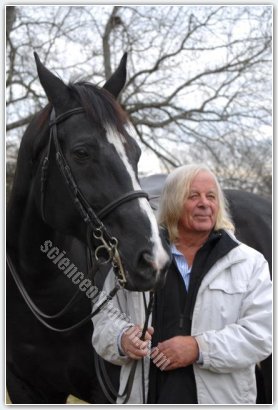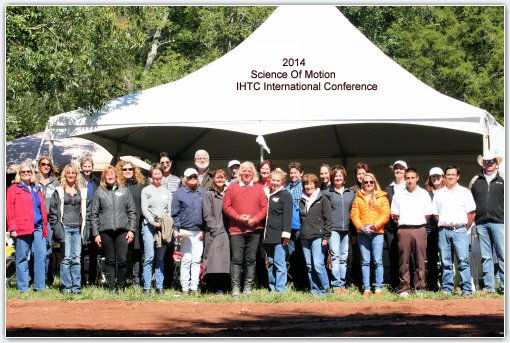International Conference 2014
Science of Motion
Second International Conference
October 4 & 5, 2014
Register for 2015 October 3rd & 4th HERE

Manchester does have an inured right stifle. We did not restored soundness treating the joint, as not much more can be done. We restored soundness teaching him proper movement. We created, at the walk, trot and canter locomotor patterns reducing the stresses on both stifles. Jean Luc
In his BIOMECHANICS OF LAMENESS IN HORSES (1976) James Rooney stated that arthritis occurred in the cartilages before spreading in the bones. The pathologist based his belief on studies effectuated in the necropsy room, under the microscope and X-rays. Since, MRI and other technologies have demonstrated that at the contrary, damages occur in the subchondral bone before they spread in the cartilage. New discoveries questioning previous beliefs, is the fundamental of evolution; this true for scientific researches and also true for riding and training principles. In fact, while exposing the inaccuracy of some concepts, new findings further James Rooney’s pertinent idea, which is that kinematics abnormalities create aberrant stresses which repeated over a period of time, cause injuries, “A major cause of lameness is lameness.”
Investigating the gait abnormality creating the lesion, James Rooney pioneered the concept known as, “The gait lesion, gait principle. The gait abnormality created by a specific lesion is the gait abnormality that causes the lesion.” Investigating the source of the kinematics abnormality causing the lesion, and developing riding and training techniques allowing correcting the root cause, the Science of Motion fills the missing link of all existing treatments and therapies. While it is necessary to understand the kinematics abnormalities causing the lesion, complete success of therapies and above all, prevention of the injury demands identifying and correcting the root cause of the kinematics abnormality. As long as the source of the abnormal stress is not addressed and corrected, the same aberrant stresses damage and re-damage the structure. Basically, without a riding and training technique capable of correcting the root cause of the kinematics abnormalities, the benefits of treatments and therapies are altered as soon as the first stride.
“Patellofemoral osteo arthritis (knee for humans and stifle for equine,) is largely biomechanically mediated and it seems logical that the specific biomechanical factors that are disrupted in a particular individual need to be addressed when designing a treatment strategy.” (Kathryn Mills, BPhty, PhD, and David J. Hunter, MBBS, MSc. PhD, FRACP. Patellofemoral joint osteoarthritis: An individual pathomechanical approach to management. 2014.) As knowledge evolves, the dependence on sound biomechanics is strongly emphasized and from his position on the horse’s back, where all body movements are created, the rider is ultimately the one that can correct the root cause and ensure proper functioning of the horse’s physique.
The thought that the rider could be the horse’s best therapy is foreign to veterinarians because actually, the situation is exactly the opposite; riding and training techniques are the main source of equine injuries. Riding and training techniques can teach the move but do not focus on preparing efficiently the horse’s physique for the athletic demand of the move. As a result, horses perform out of their talent but with kinematics abnormalities limiting their potential and developing injuries.
Understanding that lesions start in the bone before reaching the cartilage, is an evolution of knowledge as dramatic as the fact that the main function of the horse back muscles is not increasing the thoracolumbar spine’s range of motion but instead, protecting the thoracolmbar column from movements exceeding its possible range of motion. We are trained to think stretching and relaxation when in fact, muscles tendons and ligaments are designed to resist excessive range of motion. Even at the level of the stifle, stability does not result from stretching but instead from resisting forces. “Patellofemoral joint integrity is maintained by an optimal interaction of passive, dynamic and structural restraints.” The concept of restraint, which needs to be understood as protection and control, contradicts the principles of traditional equitation but is in fact more related to the functioning of the horse’s physique than stretching and relaxation. A great part of equine locomotion is the outcome of elastic strain energy stored in tendons and aponeurosis and consequently, resistance of the correspondent muscles.
Static and dynamic are very different and data collected in static situation have to be interpreted with caution. Manipulations effectuated on human cadavers allow ranges of motion that are greater than in vivo situations. For instance, in respect of the knee, the influence of tibia and femur alignment as well as kinematics of patellofemoral mechanics has been well documented. Individuals suffering of patellofemoral pain syndrome exhibit significant increase of femoral internal rotation in knee extension and flexion. However, individual who landed from a jump in increased femoral internal rotation exhibited a rotation shy of the 20°-30° threshold required to increase joint contact in cadaver. In relation to equine, James Rooney also observed damages created by increase of femoral internal rotation. “If stifle extension is carried on beyond about 143°-145°, there is a final lateral-to-medial twist, which rotates the patella medially and hooks the medial patellar ligament over the medial ridge of the femoral trochlea. The stifle is “locked” and flexion prevented.”
During forward motion, the forward swing of the hind limb and consequently the pendular movement of the femur around the hip joint is coupled with a dorso-ventral rotation of the pelvic. Mikael Holmström, who compared the gaits of Grand Prix level Swedish Warmblood with the gaits of average school horses, found that better horses exhibited greater dorso-ventral rotation of the pelvic. In the light of new knowledge, one would think that riding and training techniques would have evolved from the simplistic idea that larger spurs would stimulates greater engagement of the hind legs. The problem is that in response to intense leg actions of the riders, a horse might effectively increase the pendular motion of the femur around the hip joint. Without proportional dorso-ventral rotation of the pelvis, the horse’s submission to the rider’s legs jeopardizes the integrity of the horse’s stifles.
The rider furthers or alters the benefits of treatment regiments and therapies. There is no neutral land. However, accepting the responsibility grants the inestimable ability of preventing injuries. Abnormal stresses stimulates the development of osteoarthritis but sound stress are used to maintain bone density and consequently to retard the development of osteoporosis. Classic authors have always professed the discretion and sobriety of the rider’s aids. “Hand movements diminish as dressage progresses to the point of giving an illusion of immobility.” (General Decarpentry, Academic Equitation, J. A. Allen & CO LTD. 1971 p. 44) The greatest have hinted, between the lines, another dimension, like if the study of the rider aids were only a teaching technique educating the rider body for a more subtle body language where gestures are replaced by nuances in muscle tone. The aids, (gestures,) are no longer the finality, (obedience to the rider aids.) The aids are simply descriptions of the coordination and nuances in muscles tone that became the rider’s body language.
The work in hand practiced at the Science of Motion, suggests an even more sophisticated dimension. Muscles create energy and the ability of the horse to feel back muscles adjustments of the trainer walking by his side is more likely the perception of the energy created by the trainer’s muscular work than the nuances in muscle tone itself. We have explored this dimension riding the horses and realize that this extraordinary level of subtlety was indeed, the horse real comfort zone. Compared with the way equestrian education is taught, these concepts appear out of reach. The next discovery has been that in fact many riders have the intuition to functions at this level of sophistication but their intuitive mind has been marred by riding and training techniques limiting them to the studious application of the correct aids.
The next discovery has been that in every field, the ones who have the intellectual curiosity of applying advanced scientific knowledge, have evolved in the same direction. Instead or knee surgery, great surgeons teach their patient how to walk. Therapists involved in such rehabilitation are thinking in terms of forces and energy. University professors involved in pertinent researches have studied why women and men ride differently. Pathologist who are also riders have studied in great details the damage that have lead horses into the necropsy room hoping that teaching their knowledge will allow riders to prevent injuries or when injury happens, became active artisan of the recovery. We have asked to the bests if they would come and speak at the Second Science of Motion’s International Conferences and they have accepted.
Jean Luc Cornille

Stay tuned for next years date!
REGiSTER FOR OCTOBER 3rd & 4th HERE
Speakers
October 4th and 5th 2014 10 AM to 4 PM
Live explanations always bring a different dimension. During this 2nd International Conference, there will be numerous sessions where all the subjects treated in the IHTC will be explained live. Riding the horse, in hand, and how to teach it. Four voices will be part of the demonstrations, Betsy with her extensive knowledge and studies of equine physiology and also her personal riding and training experience, Michelle with her extensive knowledge on human physiology and her study on women and men vertebral column, Louis Louis with his enormous experience and constant research on physical therapies’ new techniques and his unequaled sene of humor. Jean Luc wearing a microphone while riding and working in hand, and the horse participating to the session.
Jean Luc Cornille M.A.(M.Phil) has gained worldwide recognition by applying practical science to the training of the equine athlete. Influenced by his background as a gymnast, Jean Luc deeply understands how equine training can be enhanced by contemporary scientific research. A unique combination of riding skill, training experience and extensive knowledge of the equine physiology enables Jean Luc to "translate" scientific insights into a language comprehensible to both horse and rider. This approach has been the trademark of his training.
Elizabeth W. Uhl, D.V.M., Ph.D., Dip ACVP- "So much information - how do I know what to believe?"
Michelle L Osborn, M.A., Ph.D.- “Why men and women do not ride the same way: Effects of the curved spine”
Louis Wild -B.A , Ma.Ed, LMT., CKTP, CESMT "Wheel Inside a Wheel and All the Wheels Go Around: IHTC Principles at the Micro Movement
Level."
No refunds


